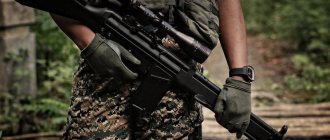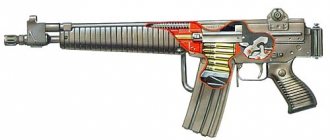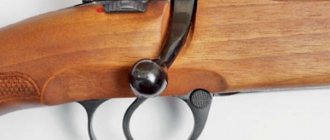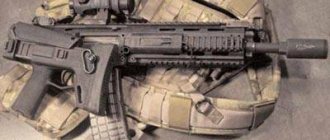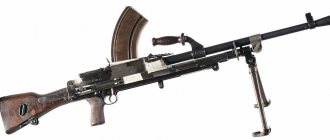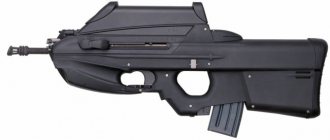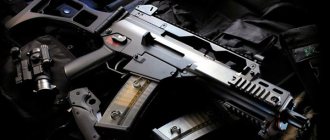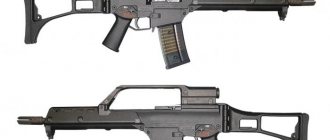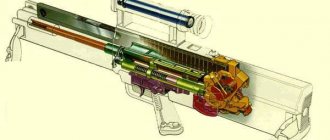Assault rifle (automatic) CETME A / CETME B (modelo 58) / CETME C
| CETME modelo C |
StG.45
At the end of the Second World War, engineers of the German company Mauser Werke, under the leadership of engineer Ludwig Vorgrimler, developed a new automatic system with a semi-free shutter, which used a pair of rollers located between the cylinder and the massive body of the shutter to brake the combat bolt cylinder. Based on this development, the experimental MG.45 machine gun and StG.45 assault rifle were created in Nazi Germany, but Germany’s defeat in the war did not allow these developments to be completed.
After the end of the war, Forgrimler moved to France, where he continued to develop the machine gun, but this time chambered for the American .30 Carbine cartridge.
In 1949, Forgrimler moved to Francoist Spain, where, together with other German engineers, he began working for the newly formed state company CETME (Centro de Estudios Tecnicos de Materiales Especiales - Center for Technical Research of Special Materials) in Madrid.
The main task of CETME was to create new small arms for the Spanish Armed Forces. cartridge 7.92x40
Based on the automation developed by Forgrimler, an experimental machine was created at CETME for a special intermediate cartridge 7.92x40 mm CETME. The new cartridge had an elongated bullet with an aluminum core.
However, at the same time, NATO countries adopted a new single standardized American cartridge 7.62x51 mm and the Spanish military leadership decided to use it in their army.
cartridge 7.62x51
At the same time, the Spaniards concluded that the NATO cartridge was excessively powerful, and therefore SETME developed its own cartridge 7.62x51 SETME/NATO, which, having the same dimensions, was equipped with a lighter bullet and carried a smaller powder charge, which, naturally, entailed a decrease in initial velocity and muzzle energy. Thus, they reduced the maximum pressure in the barrel and significantly reduced recoil, which made it possible to create a weapon that was relatively light and, at the same time, controlled in automatic fire mode.
| experimental version of CETME chambered for 7.92×40 |
After the adoption of the 7.62x51 CETME/NATO cartridge in Spain, the CETME Model A automatic rifle was developed for it, in many ways similar to that developed for the 7.92x40 mm cartridge.
In 1956, the Spanish Army adopted the CETME model A assault rifle (automatic) chambered for 7.62x51mm CETME.
| CETME modelo A chambered for 7.62×51 mm CETME |
In 1958, serial production of the CETME model B rifle began, also known as Model 58, which was an improved version of the CETME model A. CETME model B differed from model A in the presence of a device for firing a rifle grenade, a separate stamped forend (on model A the role of the forend was played by a bipod in folded), as well as the ability to fire standard 7.62x51 mm NATO cartridges (which required replacing the bolt group and return spring).
| CETME modelo A bipod folded |
In 1964, Spain decided to switch to a single NATO cartridge of 7.62x51 mm caliber instead of the CETME/NATO cartridge.
At the same time, in 1964, the modernized CETME model C rifle appeared, replacing the earlier models A and B in production and service. The main differences of the CETME model C were a more comfortable wooden fore-end, a detachable folding bipod, modified sights (instead of an open adjustable rear sight - diopter rear sight with 4 fixed settings from 100 to 400 meters in increments of 100 meters). The design of the pistol grip has changed, and the chamber has acquired longitudinal grooves (Revelli grooves), which improves the extraction of cartridges in difficult conditions and makes the weapon more reliable. The assault rifle (automatic) CETME model C was produced only under the 7.62x51 mm NATO cartridge.
| CETME modelo B/mod. 58 with a 30-round magazine |
The production of CETME series rifles was launched at the CETME pilot production and in the cities of Seville and A Coruña.
Rifles of the CETME series are built on the basis of automatic action with a semi-blowback.
The shutter opening is slowed down using a pair of rollers located between the bolt cylinder and the bolt body. At the moment of firing, the bolt body, under the pressure of the return spring, is in the extreme forward position, and its front beveled part displaces the rollers from the bolt outward, into the grooves in the barrel coupling. Under the pressure of powder gases at the bottom of the cartridge case, the combat larva begins to move backward. At the same time, due to the configuration of the grooves in the barrel coupling, the rollers seem to be pressed into the bolt, acting on the beveled front part of the bolt body and thereby forcing it to move backward relative to the combat cylinder. Due to the greater mass of the bolt body and the corresponding configuration of the parts, at the initial moment of the shot the combat cylinder moves quite slowly, and the rollers are completely retracted into the bolt only by the time the pressure in the barrel drops to safe values. After this moment, the entire bolt group (the bolt cylinder and the bolt body) moves back as a single unit, removing the spent cartridge case and feeding a new cartridge into the barrel on the way back.
| Caliber, mm | 7.62x51 CETME 7.62x51 NATO |
| Length, mm | 1015 |
| Barrel length, mm | 450 |
| Weight without magazine, kg | 4.2 |
| Store, count. cartridges | 20, 30 |
| Initial bullet speed, m/s | 780 |
| Effective firing range, m | 500 |
| Rate of fire, rds/min | 550-650 |
Rifles are fired from a closed bolt,
The trigger mechanism is trigger.
The trigger box with the trigger guard and the base of the pistol grip is stamped and hinged on the receiver behind the magazine receiver.
The charging handle is foldable, located on the left on a special tube above the barrel and does not move when firing.
The safety lever—the fire mode translator—is located, depending on the model, on the left or right side of the trigger box, above the trigger.
The receiver is made from stamped steel sheet.
Sights on CETME model A and B rifles consist of a front sight in a round muzzle in the front of the cocking mechanism tube and an open adjustable rear sight or a diopter 4-position rear sight on model C.
The weapon is fed from detachable box magazines with 20 or 30 rounds of ammunition made of sheet steel.
The design of the flame arrester allowed rifle grenades to be launched from the barrel.
There is no handguard as such on model A, steel on model B, and wood on model C.
The stock on all rifles is wooden, attached to the receiver with two transverse pins and removed when disassembling the weapon.
Model A and B rifles are equipped with a non-removable folding bipod. Model C rifles were equipped with a removable folding bipod, which, when opened, could be used as a wire cutter.
All rifles were equipped with a side-folding handle for carrying weapons, located near the center of mass of the rifle.
| CETME Sporter civil version of CETME modelo C |
Especially for the civilian weapons market, a significant number of CETME model C rifles were modified to eliminate the automatic fire mode and then sold on the civilian markets of many countries, including the United States.
In addition, in 1957, the German government entered into an agreement with the Spaniards to acquire a license for the production of these weapons and transferred the license to the young company Heckler und Koch, which later became famous for its weapons created on the basis of the developments of Forgrimler and CETME (G3 rifles, MP-5 submachine guns, machine guns NK21 and NK23, etc.).
Since the mid-1980s, 7.62 mm CETME rifles began to be replaced in the army by new 5.56 mm CETME mod rifles. L, structurally similar to 7.62 mm models.
| CETME modelo C |
Civil versions[edit]
In the 1960s, Chicago-based Mars Equipment Corporation imported semi-automatic versions of the Spanish CETME B and C rifles into the United States. Available accessories included a 1-inch scope mount, a plastic snap-on rifle cap, and a CETME magazine loading butt tool. Model B rifles included a standard integral bipod. These rifles can be identified by the large imported MARS mark on the right. - sides along with a prominent inscription “MADE IN SPAIN”. They are valued by collectors far above US made "parts kit" rifles.
In the late 1990s, Century Arms International (CAI) began offering semi-automatic, civilian-only versions known as the CETME Sporter, which are manufactured from salvaged military surplus equipment and US-made parts. Although primarily built from "C" model parts, there have been reports of "B" model parts in Century "C" model rifles. [12]
Due to import restrictions on selective fire weapon receivers, all receivers for these civilian versions are manufactured in the USA. Early receivers were made of cast aluminum, while later ones were made of stamped and welded steel. Early rifles retained the wood furniture of the originals, while later examples were available with composite stocks in the Heckler & Koch style. Due to state and local laws limiting weapons to assault weapon functions, earlier CETME Sporter models had a permanently attached muzzle brake rather than the original flash hider. After the 1994 assault weapons ban expired in 2004, Century produced models with a detachable muzzle brake. 7.62×51mm NATO ammunition can be safely used in a CETME sports car for commercial purposes. 308 is not recommended for use due to the extractor's tendency to strip rims from softer civilian brass. The CETME slow release roller lock design has an extraction and ejection process that throws the empty brass far away from the weapon. Brass generally cannot be reloaded due to dents during the ejection operation, this is of no concern when using military surplus Berdan primed ammunition.
Users[edit]
Frontline service[edit]
- Biafra - Biafran Armed Forces [13]
- Republic of the Congo [14]
- Democratic Republic of the Congo [15]
- Djibouti [16]
- Dominican Republic [17]
- France - Commandos Marine used CETME-B rifles captured aboard a smuggling vessel during the Algerian War and kept them in limited numbers until the 1990s.[18]
- Equatorial Guinea [19]
- Lebanon - Lebanese Armed Forces [20] Amal Movement
Tests only[edit]
- West Germany: CETME Model A [6]
The Spanish CETME A was also tested at Aberdeen Proving Ground in July 1954. [23] CETME Model A in 7.62 CETME and 7.62 NATO was also demonstrated to the French, Swedes and Italians in 1955. [24] Since 1957 Dutch company. Nederlandse Wapen en Munitiefabriek also demonstrated the CETME/H&K Model B rifle to the Royal Netherlands Army, the Netherlands Marine Corps, Finland (chambered in 7.62×39mm), [25] Ecuador and the Dominican Republic, but the gun was not produced nor ordered . [26]
Links[edit]
- ^ abcdefghijklmnop Hogg, Ian V.; Weeks, John (2000). Military small arms of the twentieth century
(7th ed.). Iola, WI: Krause Publications. pp. 275–276. ISBN 978-0873418249. - ^ abcde Johnston, Gary Paul and Thomas B. Nelson. Assault rifles of the world. Ironside International Publishers, Inc., 2016
- ^ abcd Walter, John (25 March 2006). Rifles of the World. Iola, WI: Krause Publications. pp. 82–83. ISBN 0-89689-241-7.
- Thompson 2022, pp. 4-5.
- ^ a b Complete encyclopedia of automatic military rifles. by AE Hartink. Hackberry Press. 2001. pp. 119 and 120.
- ^ a b c Thompson 2022, p. 17.
- Thompson 2022, p. 18.
- ^ a b c d e Thompson 2022, p. 19.
- ↑
Peterson, Philip (September 30, 2008). Gun Digest Buyer's Guide to Assault Weapons. Iola, WI: Gun Digest Books. paragraph 70. ISBN 1-4402-2672-5. - Thompson 2022, p. 13.
- Ezell, Edward Clinton; Smith, Walter Harold Black; Pegg, Thomas M. (1993). Small Arms of the World: The Essential Guide to Small Arms
. Barnes & Noble. paragraph 77. ISBN 978-0-88029-601-4. - Fjestad, SP (April 1, 2015). Blue Book of Gun Values
. Iola, WI: Blue Book Publications. p. 299. ISBN 978-1-936120-60-4. - Jowett, Philip (2016). Modern African Wars (5): The Nigerian-Biafran War 1967-70
. Oxford: Osprey Publishing Press. paragraph 46. ISBN 978-1472816092. - Jump up
↑ Gander, Terry J. (November 22, 2000).
"National inventories, Congo". Jane's Infantry Weapons 2001-2002
. item 1440. - Jump up
↑ Gander, Terry J. (November 22, 2000).
"National inventories, Congo, Democratic Republic". Jane's Infantry Weapons 2001-2002
. item 1441. - Jump up
↑ Gander, Terry J. (November 22, 2000).
"National inventories, Djibouti". Jane's Infantry Weapons 2001-2002
. item 1600. - Jump up
↑ Gander, Terry J. (November 22, 2000).
"National Inventories, Dominican Republic". Jane's Infantry Weapons 2001-2002
. item 1601. - Thompson 2022, p. 30.
- Jump up
↑ Gander, Terry J. (November 22, 2000).
"National inventories, Equatorial Guinea". Jane's Infantry Weapons 2001-2002
. item 1644. - Scarlata, Pavel (July 2009). "Lebanese Military Rifle Ammo Part 2: From Independence to Hezbollah". Shotgun News
. - Ignacio Fuente Cobo; Fernando M. Mariño Menéndez (2006). El conflict del Sahara occidental (PDF) (in Spanish). Ministerio de Defensa de España and the Carlos III University of Madrid. p. 69. ISBN 84-9781-253-0. Fuente and Marinho.
- Jump up
↑ Gander, Terry J. (November 22, 2000).
"National Cadastres, Spain". Jane's Infantry Weapons 2001-2002
. item 4230. - Thompson 2022, p. 12.
- Thompson 2022, p. 15.
- Thompson 2022, p. 20.
- Thompson 2022, p. 21.
Sources [edit]
- Manual del soldier of the infantry Marina (1985). A Marine Soldier's Guide Edited by the Spanish Ministry of Defense.
- Guide to the Basic Guide to the Escuela Técnica de Seguridad y Defensa del Aire (ETESDA) (2002). Basic Manual of the Technical School of Security and Air Defense (ETESDA) (2002). Edited by the Spanish Ministry of Defense.
- Centro de Documentación y Publicaciones del Ministerio de Defensa. Ministry of Defense Publications and Documentation Center.
- CETME: 50 años del fusil de asalto español. (CETME: 50 years of the Spanish assault rifle). Jose Maria Manrique Garcia and Lucas Molina Franco. Edit. La Esfera de los Libros. (Sphere of books). ISBN 84-9734-398-0.
- Thompson, Leroy (30 May 2022). G3 battle rifle
. Weapon 68. Osprey Publishing. ISBN 9781472828620.CS1 maint: ref=harv (link)

